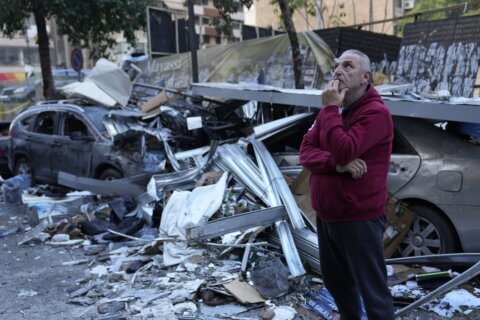FERGUSON, Mo. (AP) — Michael Brown once told his father the “world is going to know my name,” words Michael Brown Sr. still takes to heart.
Friday marks 10 years since the 18-year-old was killed by a police officer in Ferguson, Missouri, turning the St. Louis suburb into the focal point of the national reckoning with the historically tense relationship between U.S. law enforcement and Black people.
Activists marked the anniversary with a march through Ferguson, with crowds of people on foot but others in cars and SUVs honking their horns. They chanted Brown’s name and sang as they walked. Some of them linked arms.
When the march reached a memorial of stuffed animals, blue roses, lillies and candles, Brown’s father released butterflies from a box. Speakers included Fred Hampton Jr., chairman of the Black Panther Party, and Black scholar and progressive activist Cornel West.
“Justice ain’t nothing but what love looks like in public,” said West, who is running for president. He added later: “We shall never, ever forget the joy and the love of our dear brother Michael Brown.”
The elder Brown now devotes his time to the Michael Brown Sr. Chosen for Change Organization, a foundation that helps fathers, mothers and children come to grips with tragedy in their lives. It’s a legacy he feels obligated to pass on under the name he shares with his son.
“He was going to shake the world,” Brown said of his son. “So, I guess that’s what we’re doing. He’s still doing the work from the grave.”
Brown’s death catalyzed massive change in Ferguson. In 2014, every city leader was white in the majority-Black city. Today, the mayor, police chief, city attorney and other leaders are Black. The mostly-white police force of a decade ago now has more officers that are Black than white.
The municipal court system that once brought in millions of dollars in fines and fees, often for relatively minor traffic offenses — paid mostly by poor residents — now collects only a fraction of that.
But problems persist. The current and former mayor acknowledge that race still divides the community of 18,000 residents. Some are concerned that police, wary of criticism, aren’t enforcing traffic laws, since serious and sometimes fatal wrecks are common.
What happened on Aug. 9, 2014
Michael Brown and a friend were walking along Canfield Drive when Officer Darren Wilson drove up and told them to get on the sidewalk. A fight ensued and fearing for his life, the teenager ran.
Though Brown was unarmed, Wilson described Brown as menacing at 6-foot-4 and claimed he came at the officer. But some nearby residents said Brown had his hands up in surrender when Wilson shot him.
Activist Zaki Baruti recalled the horror and fear that other Black residents felt after Brown’s death.
“There was a sense of shock, not knowing what to do,” Baruti said.
James Knowles III, who was mayor in 2014, believes that the widespread anger about Brown’s death was driven by several factors. Social media allowed information — and sometimes misinformation — to spread quickly, he said. Neighbors were incensed when Brown’s body was left in the street for over four hours on that hot August afternoon.
The night after Brown’s death, thousands of protesters marched along West Florissant Avenue, near Canfield. A QuikTrip convenience store was torched, and goods were stolen from many businesses. Months of fierce protest, at which demonstrators were tear gassed, soon thrust the city into the national spotlight.
When St. Louis County Prosecuting Attorney Bob McCulloch announced in November 2014 that Wilson would not be charged, protests erupted again.
What changed in Ferguson
In 2015, an investigation by the U.S. Department of Justice also found no grounds to prosecute Wilson. But the report gave a scathing indictment of the police department — raising significant concerns about how officers treated Black residents, and about a court system that created a cycle of debt for many residents. A year later, the city agreed to a federal consent decree requiring sweeping changes. The decree is still ongoing.
Missouri lawmakers stepped in, too. In 2016, legislators passed a law limiting the amount of revenue that municipal courts could collect from fines.
In 2013, Ferguson collected $2 million in court fines and fees, according to data from ArchCity Defenders, a St. Louis-based civil rights law firm. In 2023, the city collected about $97,000 — a decline of more than 95%.
‘A new look’ for policing
Troy Doyle was a veteran St. Louis County police officer who worked in Ferguson during the 2014 protests. Nearly a decade later in April 2023, Doyle, who is Black, was hired as Ferguson’s chief — the latest of several hires since Tom Jackson resigned in 2015, following the Justice Department report.
Back in 2014, Ferguson had roughly 50 white officers, but just three Black officers. Today, 22 of Ferguson’s 41 officers are Black. Only four officers who were on staff in 2014 remain. Officers today are trained on implicit bias, de-escalation and community relationship building.
Doyle said he has worked hard to change the mindset of officers who might be resistant to the court-imposed requirements. He even replaced uniforms and changed the look of patches, badges and police cars, worried that the old look was “triggering” for many residents.
“For some people who live in the community, every time they saw a Ferguson police officer, it brought back memories,” Doyle said. “I wanted to give us a new look, but part of that new look was to let people know it was a new police department.”
Michael Brown Sr. said he’s noticed the change.
“It’s a weight that’s been lifted up off the Black community in terms of stop-and-frisk and assessing tickets,” Brown said. “There’s a lot of things that still need to get done. Those things are not promised overnight. It’s a process.”
More jobs and a helping hand
Some companies and organizations stepped in to create jobs and opportunities after the unrest in Ferguson, which brought more awareness of economic challenges in the community.
Centene Corp. opened a managed care service center in Ferguson in 2016, creating about 250 jobs. But after the COVID-19 pandemic and a move to virtual work, the center closed. In April, Centene donated the $25 million building to the Urban League of Metropolitan St. Louis for early childhood programs, workforce assistance and other services.
Bob Clark, founder of the St. Louis-based construction company Clayco, in 2015 created the Construction Career Development Initiative. Since then, 175 people have been placed in jobs in the construction industry. Among them is Malik Johnson. He was a high school student who was homeless at the time of Brown’s death.
“My reality was divorce. My reality was mom with breast cancer, homeless, going hungry,” Johnson, 28, recalled. “Not knowing what tomorrow looks like.” Now, he’s married, employed as a pipefitter and planning a family.
But challenges remain
After serving three terms as mayor, Knowles left office in 2020 due to term limits.
Knowles frequently meets for breakfast with Ella Jones, who was elected as Ferguson’s first Black mayor in 2020 and reelected last year. They both acknowledge that race relations remain a struggle.
“The city is turning back,” Jones told the St. Louis Post-Dispatch. “It really is. Everything here is along racial lines.” The City Council has four white members and three Black members, and little gets done, she lamented.
Knowles sees that, too. He also worries about public safety as many drivers — aware police are less likely to pull them over — flaunt traffic laws.
He also believes too much money is being spent on the consent decree — money he believes would be better spent on fixing streets, hiring more officers and restoring crumbling parks.
The place where Black Lives Matter took off
Karla Scott, communications professor and former African American Studies program director at St. Louis University, said Ferguson will survive because its residents are resilient and proud of their community, even after all it has gone through.
“But I think it will always be the sort of epicenter for many of us who can remember where we were when we heard the news, or for people who went out there to stand in solidarity, to march in solidarity, to make their voices heard,” Scott said. “It will always be that place where the Black Lives Matter movement really took off.”
During Friday’s memorial march in Ferguson, participants chanted the words that started it all. “Hands Up! Don’t Shoot!” as well as “Say His Name! Mike Brown!”
They laid blue roses on the pavement of Canfield Drive, then yelled, “Whose street? Our street!” and “We’ve got to fight back!”
A few carried American and other flags and signs such as, “Injustice anywhere is a threat to justice everywhere.” Hampton, the Black Panther leader, encouraged participants to raise their arms and clench their fists to give its Black power salute.
“Differences amongst the people are reconcilable. However — however, differences between the people and the state are irreconcilable,” Hampton said. “Ain’t no forgiving what they did to Mike Brown.”
——
This story is part of an AP ongoing series exploring the impact, legacy and ripple effects of what is widely called the Ferguson uprising, which sparked outcry over police violence against Black Americans and broader calls for solutions to entrenched racial injustices nationwide.
Copyright © 2024 The Associated Press. All rights reserved. This material may not be published, broadcast, written or redistributed.







